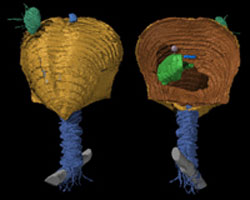Soft body fossils of extinct ’lamp shell’ digitally reconstructed

Lamp Shade’ fossil recovered from 250 million year old Herefordshire, U.K. lava ash
A team of American and British scientists have identified and digitally reconstructed the first example of a fossilized brachiopod complete with its pedicle, the stalk attaching it to the sea floor, and its lophophore or feeding organ, according to a report in the journal Nature.
Brachiopods, the so called “lamp shells,” are rare today, but are some of the best known fossils from the Paleozoic era — 542 to 251 million years ago. Our knowledge of these extinct forms was previously based almost entirely on their shells, which are all that normally fossilize.
Derek Briggs, professor of geology and geophysics, and director of the Yale Institute of Biospheric Studies, with his colleagues Mark Sutton at the Imperial College, University of London, Derek Siveter at University of Oxford and Professor David Siveter at University of Leicester conducted their research on the fossil deposits in Herefordshire, U.K.
This extraordinary trove of fossil records was buried under the sea in volcanic ash that is 425 million years old. The site is unusual because it yields fossils of the entire animals, including soft body parts that the researchers then can reconstruct digitally.
“This specimen is particularly interesting as several smaller brachiopods have attached themselves to its shell, two of them also preserving pedicles,” said Briggs.
The brachiopod belongs to an extinct group, and this work reveals that its pedicle differs from that on living forms. Previous assumptions that extinct brachiopods were very similar to modern examples may thus be too simplistic.
Other specimens of interest from the volcanic ash at Herefordshire that were recently reconstructed by the team include an ancient sea spider and the oldest fossil animal that is “definitively male.” [see Release #1 and #2 below]
Media Contact
All latest news from the category: Earth Sciences
Earth Sciences (also referred to as Geosciences), which deals with basic issues surrounding our planet, plays a vital role in the area of energy and raw materials supply.
Earth Sciences comprises subjects such as geology, geography, geological informatics, paleontology, mineralogy, petrography, crystallography, geophysics, geodesy, glaciology, cartography, photogrammetry, meteorology and seismology, early-warning systems, earthquake research and polar research.
Newest articles

Properties of new materials for microchips
… can now be measured well. Reseachers of Delft University of Technology demonstrated measuring performance properties of ultrathin silicon membranes. Making ever smaller and more powerful chips requires new ultrathin…

Floating solar’s potential
… to support sustainable development by addressing climate, water, and energy goals holistically. A new study published this week in Nature Energy raises the potential for floating solar photovoltaics (FPV)…

Skyrmions move at record speeds
… a step towards the computing of the future. An international research team led by scientists from the CNRS1 has discovered that the magnetic nanobubbles2 known as skyrmions can be…




















